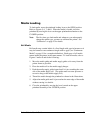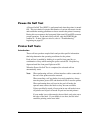
Zebra S-Series User’s Guide 23
%®lÃAÏ
2SHUDWLQJ<RXU=HEUD66HULHV3ULQWHU
Now that your printer is ready for operation, how does it work? The Zebra
S-Series Printer is designed to receive instructions from a host computer,
such as an IBM-compatible PC. To create a label, you either need to use
label design software or write a format in ZPL II
®
, which is a
programming language for creating label formats. If you are using label
design software, refer to the instructions provided with your software
package to determine how to proceed.
If you are using, or plan to use, ZPL II, make sure you have a copy of the
ZPL II Programming Guide. This guide is available by contacting your
distributor or Zebra Technologies Corporation. For some sample ZPL II
label formats, see page 35. But first, we’ll describe the different operating
modes.
3ULQWHU2SHUDWLQJ0RGHV
The S-Series Printer can be configured for several different modes of
operation by sending the proper commands from the host computer.
Operating modes may also be configured via a bank of DIP switches at the
rear of the printer. (See “Option Switches” on page 39 for more
information about DIP switches.)
0HGLD6HQVLQJ0RGHV
There are two basic modes by which the printer can sense the position of
the media: transmissive sensing mode and black mark sensing mode. The
160S comes standard with both transmissive sensing mode and black mark
sensing mode capabilities. The 105Se comes standard with transmissive
sensing mode capability, but may be factory ordered with an additional
black mark sensor.


















